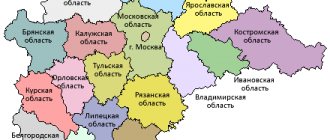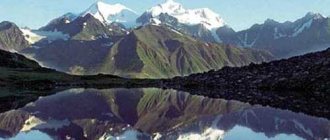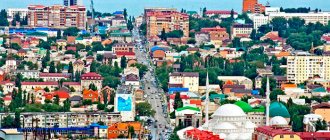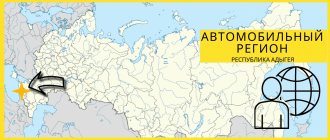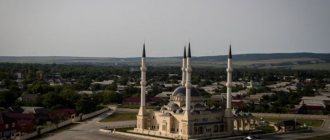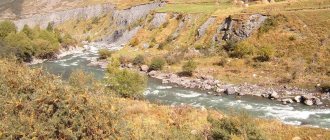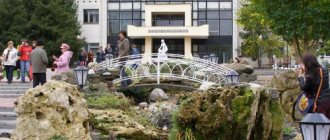The North Caucasus is the southern region of Russia with the largest population. The republics of the North Caucasus have their own rich roots, extensive history and charisma. The people of this region are distinguished by their hospitality, generosity and generosity. There are also rich musical traditions. The nature of the region is truly unique. Many come here from afar just to see this miracle. Such beauty simply takes the breath away for many tourists. The culture of this region is also interesting and diverse.
Geographical position
There are South and North Caucasus. The northern part of the Caucasus is located on the northern slope of the Greater Caucasus Range, as well as on the southern slope to the Psou River.
Extreme points:
- the northern point of this region is the village. Oktyabrsky, Stavropol Territory;
- southern point - village. Kurush (Dagestan);
- eastern point - Krainovka (Chechen Republic);
- western point - Kurdzhinovo.
This region is located in the south of the Eurasian continent; it is the largest region of the country in terms of territory. Its total area is 258 thousand square kilometers. And, of course, its population is also considerable - it is the most densely populated region.
The Caucasus was annexed to the Russian Federation at the end of the 19th century, after the end of the Caucasian War. It borders with Georgia, Abkhazia, Kalmykia, and the Krasnodar Territory. It is washed by the waters of the Caspian Sea on the eastern side.
In the north, this region borders on the Southern Federal District, which includes the Rostov, Astrakhan, Volgograd regions, etc.
Climate of the North Caucasus
Almost throughout the entire region the climate is temperate continental. Only on the Black Sea coast does it become subtropical. Thanks to this, in the North Caucasus you can see steppes, semi-deserts, and forests. The sun shines almost all year round in the North Caucasus, and above-zero temperatures prevail. In general, the climate here is conducive to agricultural activities - you can harvest crops several times a year.
Winters in the North Caucasus have little snow, and in some regions snow may not fall at all. The average annual temperature is at least +10 degrees. C. Summer temperatures range from +23 to +29 degrees. WITH.
Territorial division
Currently, the Caucasus covers two autonomous regions of Russia: Stavropol and Krasnodar and seven republics. Many are now debating whether the Foothills are included in this region. Then this concept must include both the Rostov region and Kalmykia.
Republic
Now this region includes seven republics:
- Adyghe;
- Karachay-Cherkessia;
- Kabardino-Balkarian;
- North Ossetian;
- Ingush;
- Chechen;
- Dagestan.
Each of these republics is unique, beautiful in its own way, has its own ancient history and rich traditions, which have been strictly revered since ancient times to this day.
Adygea
The capital of this subject of the Russian Federation is the city of Maykop. The republic is part of the North Caucasus economic region. It is the only one of all the republics that is located on the territory of another region (Russia).
Adygea is located on the slopes of the North Caucasus and the plains of the Kuban. Its total area is 7800 square km. The climate of the republic is temperate continental, due to its close location to the Black Sea, and the mountains contribute to increased humidity levels in this region.
Karachay-Cherkessia
This republic has been part of Russia since 1957, its capital is the city of Cherkessk. It is located in the foothills of the Caucasus, but most of it is located in mountainous areas. On the border of the republic with Kabardino-Balkaria there is the highest mountain in Europe - Elbrus.
The population of this region speaks several languages:
- Russian;
- Nogai;
- Circassian;
- Karachay;
- Abaza
Russian is considered to be the official language here. The area of the republic is 14 thousand square meters. km.
There are many mineral deposits located on the territory of Karachay-Cherkessia:
- coal;
- granite;
- marble;
- ores;
- clay.
The republic is also famous for its healing mineral waters, which attract many visitors.
Kabardino-Balkaria
The capital of this subject of the Russian Federation is Nalchik. Its total area is 12,400 square meters. km.
The population speaks the following languages:
- Kabardian;
- Balkar;
- Russian;
- Ossetian;
- Turkish
The republic is located in the central part of the North Caucasus slope. The highest point of Elbrus is located on its territory. There are also five main ridges on it.
Kabardino-Balkaria is famous for its attractions:
- waterfalls (Gedmishkh, Sultan, Abai-Su);
- lakes (Tambukan, Shadhurey, etc.);
- rivers (Terek, Baksan, Malka).
Previously, there were two regions on the territory of this republic - Balkaria and Kabarda. They united in 1922.
North Ossetia
It has a different name - Alania, the capital of the republic is Vladikavkaz. It was founded in 1924. The population speaks Russian and Ossetian languages. The total area is 8 thousand square meters. km. It is located on the plains, and Kazbek peak is also located on its territory.
The republic has rich mineral deposits:
- lead;
- copper;
- oil;
- silver
There are also sources of medicinal mineral waters here.
Ingushetia
The capital of the Ingush Republic is the city of Magas. It has an area of 3.6 thousand square meters. km. It is the smallest region of the country. The north of Ingushetia is located in the steppes, the southern part is in the mountains. The largest peak is Mount Shan.
The climate here is temperate continental. Time zone: Moscow.
The republic is famous for its attractions:
- Furtoug Falls;
- Nazranka River;
- Sunzha River;
- Assa River.
This is not the entire list of rivers; their total basin is 3 thousand square meters. kilometers.
Ingushetia has rich mineral deposits:
- oil;
- marble;
- natural gas.
Also in the republic there is a source of Borjomi mineral water.
Chechnya
In Soviet times, Ingushetia and Chechnya were united into one republic - the Chechen-Ingush Autonomous Soviet Socialist Republic. Their division into separate republics occurred in 1993.
The capital of Chechnya is the city of Grozny. The total area of the republic is 15 thousand square meters. km.
Its relief is divided into four parts:
- Terek-Sunzha Upland;
- Terek-Kuma lowland;
- mountainous part;
- plain.
The mighty Terek River flows through the middle of the republic, sung by many poets. From north to south, the plain gradually gives way to mountains. Chechnya is famous for its beauty: deep lakes, waterfalls, turbulent mountain rivers. Lake Kezenoyam is especially famous. It is located high in the mountains, has the greatest depth and the purest water. It is home to trout. The beauty of this land is truly perfect.
The population speaks Russian and Chechen. The republic is known for its war with Russia in the 90s of the last century. Then it caused enormous damage to buildings and agriculture. Work is currently underway to restore civilian facilities.
Dagestan
The capital of Dagestan is the city of Makhachkala. The total area of the republic is 50 thousand square meters. km. Previously, this territory was the Caucasus province. In 1860, the Dagestan region was formed. In 1917 it was transformed into the Mountain Republic. Then it began to be called the North Caucasus Emirate. Since 1921 it has been the Dagestan Autonomous Soviet Socialist Republic.
The population of the republic is quite diverse, as is the religion of the peoples. Dagestan is famous for its ancient fortresses and temples. There is a nature reserve on the territory of the republic. Currently, mechanical engineering is developed.
The nature of Dagestan is beautiful - mountains, lakes, rivers. The climate is temperate continental, arid in places. Relief: mountains, foothills, plains.
This republic gave the world a famous poet - Rasul Gamzatov, who glorified the beauty of his native land and the generosity of the people in his works.
Pyatigorsk
Pyatigorsk is the oldest mud clinic in Russia. A large number of sanatoriums, boarding houses, children's camps and tourist centers annually welcome thousands of Russian and foreign tourists. In Pyatigorsk you can not only improve your health, but also enjoy the sights of this resort.
One of these attractions is the Lermontov Museum-Reserve. In practice, this is a complex of four objects of historical significance: Lermontov’s house, the Alyabyev house museum, the literary department, and the Lermontov department in fine arts.
A monument erected on the site of the famous duel between Lermontov and Martynov, which took place on the slope of Mount Mashuk, has been declared a cultural heritage of the country.
You can also visit the Mikhailovskaya Gallery. Now it is an art gallery, but historically it is the first Narzan gallery in the Caucasus.
On Mount Mashuk, or rather on the Mikhailovsky spur, there is the “Eolian Harp”, a gazebo, the prototype of which was the London Temple of Aeolus. For about a hundred years, there stood an air harp, a musical instrument (aeolophone), the strings of which produce melodic sounds thanks to gusts of wind.
A cave was formed on Mount Mashuk, the depth of which is about 40 meters; the cave resembles a funnel, the bottom of which is filled with turquoise-colored water.
At the approach to Lake Proval there is a two-meter high monument to the great schemer Ostap Bender. Lake Proval itself is a unique natural attraction, the pearl of the resorts of the North Caucasus.
History of formation
According to ancient written evidence, the first inhabitants of these places were the Cimmerians. They were engaged in cattle breeding and fought with the Scythians who entered their land. In the fourth century AD, the Huns began to invade these places. In the 7th century, Turkic-speaking Bulgars moved here. In the 8th century, the Caucasus belonged to Khazaria.
In the first millennium, four regions were formed in the Caucasus:
- Pre-Caucasian;
- Dagestan;
- Zakubansky;
- Central Caucasian.
The ancestors of the Circassians were located on the left bank of the Kuban. In the eastern part of the Kuban region there was the ancient country of Alania (the ancestor of modern North Ossetia).
From the 7th to the 10th centuries, the Arab conquests of the Caucasus took place. They spread Islam among the local population. In the 13th century, the Mongol campaigns began in the Caucasus. They completely destroyed the population of Alanya. In the 16th century, the struggle for the Caucasus began between Iran and the Ottoman Empire.
At the same time, the Russian state occupied the lands of the Caucasus. The Russian border passed through this region in the 16th century. At this time, the Terki fortress was built at the confluence of the Terek and the Sunzha. Russian Cossacks settled there and began to be called “Terek”.
In the 18th century, Ossetians and Ingush joined Russia. At the same time, our state took away the right bank of the Kuban River from Turkey. Zaporozhye Cossacks began to move there. The city of Ekaterinodar (Krasnodar) was founded.
In the same century, the Caucasian province was founded. It included six districts, its center was Ekaterinodar. Then in the 19th century the city of Armavir was founded.
After the October Revolution, the province began to be called the Mountain Republic. Two years later it split into separate areas. They became part of the USSR as autonomous republics. After the collapse of the Soviet Union, they again became independent, but are part of Russia.
The Caucasus - where it is located and what it borders on
On the world map, the mountainous area can be found on the border between Europe and Asia; it covers an area of about 450 thousand km2. Having basic knowledge of geography, it will be easy to imagine the volume of the territory according to geographical coordinates - 38°25' - 47°15' north latitude, 36°37' - 50°22' east longitude.
The territory is limited from the east by the Caspian Sea, and from the west by the Black Sea and Azov coasts. The northern border of this region is considered to be the Kuma-Manych depression. Southern - the republics of Iran and Turkey.
Policy
The Plenipotentiary Representative of the President of Russia in the North Caucasus is Alexander Anatolyevich Matovnikov. He was the commander of the Special Operations Forces of the GRU of the General Staff of the Russian Armed Forces. He holds the rank of lieutenant general.
The foreign and domestic policy of the Caucasus remains the country's most pressing problem due to armed conflicts. For two decades now, the situation in this region has remained turbulent. Great efforts and attention are needed to resolve these issues.
The first Chechen conflict was from 1994 to 1996. After the declaration of war on Russia, Russian troops were sent into Chechnya. Contrary to expectations, it was not possible to quickly resolve the situation. The conflict dragged on for two years. Many Russian guys died. The Chechens turned into terrorists and took hostages—civilian village residents. In 1996, a truce was achieved.
But three years later, the Chechen conflict flared up with renewed vigor. The militants again began terrorist activities, and Russian troops had to be sent into Chechnya again. The bandits were driven into the mountains. The fighting ended by 2002. The following year, the Chechen Republic was formed, President Kadyrov was elected, and a constitution was adopted.
The Russian government suffered great losses, both material and moral. More than 25 thousand Russian people were killed in this war. This number exceeds losses during the Afghan war.
Until now, there are complex relations between the peoples of the Caucasus. Therefore, our government tirelessly protects state security.
The situation in the region is especially dangerous due to aggressive actions by Islamists.
Where does the journey begin?
A trip to the resorts of the North Caucasus, as a rule, begins in the city of Mineralnye Vody. This is the administrative center of the Mineralovodsk region.
There are no healing springs here. This is a major transport interchange in the North Caucasus. There is an international airport, the largest in southern Russia, a federal highway, and an extensive railway.
You will get to the desired resort city by highway or by train. Resorts of the North Caucasus always welcome guests. At any time of the year, here you can not only improve your body, but also remember what clean air and real relaxation are.
National composition
People of different nationalities live in this region. These are representatives of different anthropological types of Caucasian races.
Representatives of the Caucasian type:
- Aguls;
- Balkars;
- Dargins;
- Ingush;
- Karachais;
- Lezgins;
- Ossetians;
- Chechens;
- Georgians;
- Kakhetians, etc.
The Pontic type includes:
- Abkhazians;
- Adyghe people;
- Kabardians;
- Circassians;
- Pontic Greeks;
- southern Russians and Ukrainians.
Representatives of the Caspian subtype:
- Kumyks;
- Azerbaijanis;
- Tsakhur;
- tatas, etc.
The Armenoid type includes:
- Assyrians;
- Armenians;
- southeastern Georgians.
In terms of population in this region, the palm is held by the Chechens, Adygs, and Abkhazians. The natural increase in the birth rate here is quite high. And mortality is reduced compared to other zones due to favorable living conditions and morality (mountain peoples do not have abortions and raise their youth strictly).
Fauna of the North Caucasus
The diversity of the animal world is not inferior in its diversity to the plant world. Each climate zone has its own inhabitants, many of them are endangered species and are protected.
In desert and semi-desert natural areas you can find typical inhabitants - gophers, jerboas, hedgehogs. Among the predators are the wolf and the corsac dog. Forest inhabitants include foxes, moles, badgers, wild boars, mice, hares, deer, and lynxes.
If you go up into the mountains, you can meet chamois and fallow deer. The best way to study the fauna of the North Caucasus is in nature reserves - there are plenty of them here, and the fauna is presented in all its diversity. Honorary inhabitants of protected areas are animals recognized as rare and endangered: bison, leopards, leopards, etc.
Relief and climate
The relief of this beautiful region is varied. Usually, judging by its name, it is associated with the Caucasus Mountains, but on the map not all of its territory is located in mountainous areas. For example, the north of the region lies on plains called the “foothills of the Caucasus.” Gradually, to the south there is an increase in the terrain, which turns into mountains called the Greater Caucasus.
The altitude also varies from one area to another. For example, the Stavropol Territory is located at an altitude of 2.3 km above sea level, and the northern foothills are at an altitude of 600 m.
The climate in this region also varies depending on location. Mainly temperate continental prevails, but arid tropical is also found.
Flora
The nature of this region is truly unique. It is unlikely that such beauty can be found anywhere else on the planet. High mountain peaks covered with snow, fast mountain rivers, clear lakes, magnificent waterfalls. All this is due to the features of the relief. The vegetation of this region deserves special attention. The strange flowers that grow at the foot of the mountains are bright, as if painted.
Since ancient times, these places have attracted creative people: artists and poets. Pushkin and Lermontov were inspired by the local nature. They loved to visit here often, because they were inspired by the beautiful landscapes.
The Caucasus is famous for its medicinal herbs. Many useful plants grow in this area that help with various ailments.
Among them:
- Horse chestnut (helps with varicose veins, blood clots, high cholesterol).
- Lungwort (useful for pancreatitis, cholecystitis, gout, diabetes, female bleeding).
- Chernogolovka (stops bleeding, has an antimicrobial and astringent effect).
- Adam's root (useful for impotence, rheumatism, gout, osteochondrosis).
Fauna
The fauna of the Caucasus is no less diverse and unique. Rare species of individuals are found here, many of them are listed in the Red Book. Nowadays, it is increasingly rare to see animals such as bison, black stork, and Hungarian goat. There are minks in the rivers, where they hunt fish. The mountains are inhabited by roe deer, mountain goats, wild boars, and wild bears.
Features of the North Caucasus
The main feature of the region is that it is equidistant from both the equator and the north pole. That is why the nature of the region can be called unique.
The North Caucasus boasts magnificent flora and fauna. More than 6 thousand plants grow here, while throughout the rest of the vast territory of Russia there are half as many of them. A special place is occupied by relict plants, which are almost impossible to find in other regions.
The fauna is represented by inhabitants of steppes, forests, deserts and semi-deserts.
In order to preserve the richness of the nature of the North Caucasus, the Caucasian State Biosphere Reserve was created here, which is the very first in Russia.
Religion and culture
Religion
The religious denominations of the residents are different. Most of the population professes Islam.
Among them:
- Avars;
- Adyghe people;
- Balkars;
- Ingush;
- Kabardians;
- Karachais;
- Lezgins;
- Nogais;
- Chechens;
- Circassians;
- Azerbaijanis;
- tatas, etc.
There are Orthodox Christians among the population of the Caucasus.
These include:
- Ossetians;
- Abkhazians;
- Georgians;
- Russians;
- Ukrainians.
There are also Christians of other denominations:
- Armenians;
- Assyrians;
- undines.
Among the Jews are Mountain and Georgian Jews. In this area you can find Orthodox churches next to mosques. Muslims have a normal attitude towards the presence of other religions, not counting the militant ones, which have repeatedly caused armed conflicts based on religious affiliation between the peoples of the Caucasus.
Culture
For a long time, cultural traditions have been revered in these places. Unique melodies, fire dances, peculiarities of singing songs - all this is passed on from generation to generation. Folk singing is more widespread here than anywhere else, and many have an excellent ear for music. Songs accompany all rituals in this area, from the birth of a child to funerals.
Unique wedding and folk holiday chants vary depending on location. Among the Terek Cossacks you can hear something that is not at all similar to Ossetian.
Dances of mountain peoples are a separate topic. It’s rare to find such rhythmic, unique, fiery dances. Take at least Lezginka.
The costumes of the peoples of the Caucasus are also varied. Adygs, for example, can be easily distinguished from Chechens. But all the peoples of this region share common characteristics: reverence for elders, love of tradition, respect for women, courage and self-sacrifice.
Geological structure and minerals
Oil is one of the most significant mineral resources of the southern regions. During the war with the Soviet Union, Hitler sent part of his army in this direction with the aim of capturing the most valuable of natural resources - “black gold”.
These are Paleogene and Neogene rocks occurring in the Dagestan, Grozny and other regions. No less famous is the Absheron oil field in the eastern part of the Kura Depression. It is composed of river sediments from the deltas of the ancient Volga and Kura, which once flowed into the lake of the South Caspian depression.
The upper soil is composed of sands and clays. The lower, sedimentary layer contains hydrocarbons - this is where oil deposits are located. In recent years, more ancient strata of the Republic of Dagestan and the Krasnodar Territory have been developed.
The gas fields of the mountainous region are no less important. People have been benefiting from this wealth for a long time. For example, the Dagestan glass factory has been operating on natural gas for several centuries. The cities of Stavropol and Grozny are rich in gas. Even before the revolution, natural resources were mined in them for heating premises. Large deposits have also been discovered in the Krasnodar Territory, which currently ranks first in gas reserves in Russia.
The western region of Georgia is famous for its coal mining. And, although the reserves of this mineral are not so large, it is of significant importance in industry.
The mountainous country is rich in ores. Almost all metals needed in industry are concentrated here. The most significant representatives: copper, zinc, iron, arsenic, aluminum.
Economy
The economy of this region is directly related to exports, because this is where natural gas and oil are produced. Rare and non-ferrous metals (lead, zinc, molybdenum, tungsten, etc.) are mined in mountainous areas. The Rostov region is rich in coal. The foothills are a storehouse of metallurgical, chemical, and construction raw materials.
Mechanical engineering is also developed here. The large enterprise RosNefteGazInstrument is known. Oil and gas equipment for drilling wells is produced here.
The entire Caucasus is also called the “health resort of Russia.” People from all over the country come here to relax, recuperate and heal. Many sanatoriums are located in the mountains. Those suffering from diseases of the digestive and excretory system are treated with mineral waters. Pyatigorsk and Minvody are centers of healing springs.
The Baku-Novorossiysk oil pipeline and the Blue Stream gas pipeline connecting Turkey and Russia pass through this region. Large highways lead to Novorossiysk (M4 Don), and the M29 Caucasus highway leads to Mineralnye Vody.
This region is considered particularly fertile. The harvest is harvested several times a year due to the warm climate and favorable conditions.
Large cities of the North Caucasus
There are no million-plus cities in the region.
Krasnodar . The largest is Krasnodar - its population is slightly less than one million people. This city is the economic center of the entire North Caucasus. Krasnodar is a very modern, rapidly developing and beautiful city. It is not for nothing that it is called the “Southern Capital of Russia”. The warm climate and the fact that the city is located close to the Black Sea resorts make it very attractive for living.
Stavropol . The population of this city is approaching 500 thousand people. For several years in a row, Stavropol received the title of the most comfortable city in the country. It is also called one of the greenest cities in Russia - there are many parks, squares, flower beds and front gardens. The city has many attractions and other places attractive to tourists.
Sochi . The population of the city after the 2014 Olympics increased sharply and exceeded 400 thousand people. A sporting event of world significance gave Sochi a sharp impetus - it was transformed and began to develop at a rapid pace. Today this city is the most attractive for permanent residence. This is one of the largest and most beautiful resorts in the country, the economic and cultural center of its region.
Grozny . Despite the hostilities that raged in the city not so long ago, now the city looks beautiful and modern. It was literally rebuilt from scratch, and now Grozny is the pride of the North Caucasus. Its population is almost 300 thousand people. Every fifth resident of Chechnya lives here. Grozny combines two cultures – Russian and Chechen. Guests of the city can be convinced that both nationalities are treated with equal respect.
Makhachkala . If we take the population of the city together with its suburbs, the result is a number close to a million people. Those who come here for the first time are amazed by the appearance of Makhachkala, which is unlike any other city in Russia - the architecture here is very unusual. The capital of Dagestan is the fastest growing city in Russia. Over the past decade, its population has increased by a third. This growth is due to the fact that the majority of residents are Muslims, and their tradition is to have many children.
Interesting Facts
In the Caucasus, the places of residence of the great Russian poets - Pushkin and Lermontov - are honored. Monuments to Pushkin stand in the places where he visited (in the city of Ordzhonikidze, Georgievsk, Pyatigorsk. It was here that he wrote his brilliant work “Prisoner of the Caucasus,” although it was originally intended to be created in Georgia. This poem was based on descriptions of the nature of the Caucasus.
Lermontov also often visited these places.
He lived :
- in Pyatigorsk;
- in Stavropol;
- in Zheleznovodsk;
- in Chechnya;
- in Dagestan;
- in Kislovodsk.
The poet loved the Caucasus very much; descriptions of the local nature can be found in many of his works (“Hero of Our Time”, “Demon”, “Mtsyri”, “Dream”, etc.) At first he was forced to visit these places for health reasons, but over time he loved the Caucasus so much that he could not live without it. how many oceans are there on earth, read our article.
Sights of the North Caucasus
Nyryn-Kala fortress . This is the oldest fortress in the country, more than 1600 years old. Located in Dagestan, in the city of Derbent. The fortress was built as a defensive structure - it is located on a high hill and has thick impenetrable walls. The fortress receives visitors every day. Its walls offer stunning views of the surrounding area, and inside there are preserved buildings from different eras, from the 6th century to the 19th century.
Mosque "Heart of Chechnya" . Built in Grozny in 2008, it became the largest mosque in Russia. The building is located in the middle of the park, surrounded by alleys and fountains. The walls of the mosque can accommodate more than 10 thousand people. Tourists can view the inside of the mosque during breaks between prayers.
Barkhan Syrykum . It bears the title of the largest single dune in Europe - its height is about 250 m. It is located in Dagestan. This area is a zone with its own special microclimate - the air temperature here from May to September does not fall below +20 degrees. S. Experts say that the Syrykum dune is at least several hundred thousand years old.
Caucasian Mineral Waters . This definition includes several resorts: Pyatigorsk, Essentuki, Kislovodsk, Zheleznovodsk. There are about 130 healing springs on the territory of these cities. Each of the resort cities specializes in the treatment of different diseases. The sanatoriums of Mineralnye Vody are never empty - space is in great demand. Dargavsky necropolis. This place is called the city of the dead. The number of crypts located both outside and inside the earth is enormous. The oldest of them date back to the 9th century AD. You can take an excursion to the necropolis every day; admission is paid.
Mountain Elbrus . It is located on the border of two republics - Kabardino-Balkarian and Karachay-Cherkess. One of the largest ski resorts in Russia is located in the Elbrus region, which welcomes guests from December to May. At an altitude of 3.5 thousand meters there is a museum, which is the highest located in the world.
Main types of landscapes
The southern region is diverse in landscape.
Conventionally, it can be divided into three zones:
- mountain;
- foothill – located south of the steppe zone and ends with mountain ranges;
- steppe - a territory concentrated between the Kuban and Terek rivers.
The steppes are plowed and sown. Spaces not occupied by crops are used as pastures. Beech, ash, and oak grow in forest-steppes. The fauna of the Caucasus is similar to that of Central Asia: in the fields you can find long-eared hedgehogs, jerboas and reed cats.
The mountainous territories are divided into the Greater and Lesser Caucasus, occupied by meadows, mountains and forests, in the space of which beech, pine, and hornbeam grow; and the Armenian Highlands with steppes, which are used for hay harvesting and animal walking.
The nature is similar to Western Europe: deer live in the forests, bear, lynx, and fox are common. Less commonly you can see the jerboa and gopher.
Glaciation
At the beginning of the twentieth century, glaciation amounted to 1967 km2. Due to a certain direction of wind flows, the glaciation of the northern slope of the mountains is more significant than the southern one.
The largest area of glaciation has the inactive volcanoes Elbrus (Yalbuz) and Kazbek, which are 143 km2 and 135 km2, respectively. Today, the length and thickness of the ice sheet have decreased, for example, the glaciation of Elbrus has decreased by about 10%.
Another problem in the Caucasus is the formation of mudflows arising from rain and snow, as well as from melting ice. If there is little rainfall over a long period of time and the temperature drops, then melt water accumulates in the valleys and, mixed with moraines, forms mudflows, posing a great threat to the human economy.
